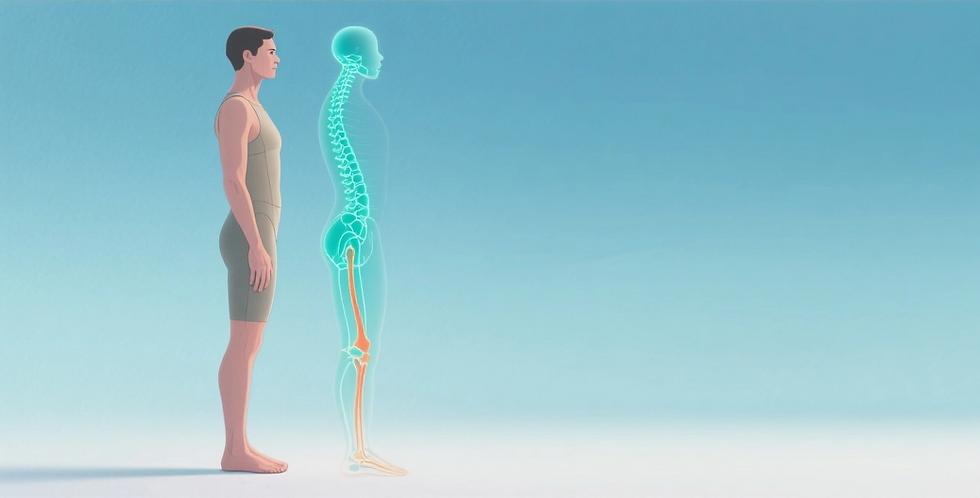Scapular Dyskinesis: Holistic Treatment with PDT-R, Eye Correction, and Posturepro Method
- Luc

- Jan 22
- 5 min read
Updated: Feb 3
Understanding Scapular Dyskinesis: Beyond Just Shoulder Pain
Living with shoulder pain and limited mobility can be debilitating. If you suffer from shoulder discomfort, it could be a sign of scapular dyskinesis, a condition that affects the proper movement of the scapula (shoulder blade). This article explores a holistic treatment approach to address both the symptoms and the underlying causes of scapular dyskinesis, incorporating PDT-R (Proprioceptive Deep Tendon Reflex), eye correction, and the Posturepro Method with therapeutic insoles.
What Is Scapular Dyskinesis?
Scapular dyskinesis refers to abnormal movement or positioning of the scapula, which can lead to shoulder pain, decreased mobility, and dysfunction. It often arises from muscle imbalances, poor motor control, or compensatory movement patterns. Common symptoms of scapular dyskinesis include:
Medial or inferior border prominence of the scapula
Early scapular elevation or shrugging during arm movement
Rapid downward rotation when lowering the arm
While conventional treatments typically focus on the shoulder, the root causes often extend beyond this area, affecting regions like the feet or visual system. This comprehensive article delves into holistic treatments, combining PDT-R, eye correction, and therapeutic insoles to restore balance and function.
For a deeper understanding of scapular dyskinesis, check out this comprehensive review on scapular dyskinesis from the International Journal of Sports Physical Therapy.

Short-Term Relief with PDT-R (Proprioceptive Deep Tendon Reflex)
PDT-R is an effective technique for providing immediate relief from scapular dyskinesis symptoms. By targeting muscle imbalances—both overactive and underactive muscles—PDT-R helps restore proper scapular movement. Common muscle imbalances associated with scapular dyskinesis include:
Overactive anterior shoulder muscles (e.g., pectoralis minor)
Underactive posterior shoulder muscles (e.g., lower trapezius, serratus anterior)
Overworked upper trapezius and underutilized latissimus dorsi
Through precise application of PDT-R, these imbalances can be corrected, leading to immediate improvements in scapular mobility and pain reduction. However, while PDT-R is effective for short-term relief, it does not address the underlying biomechanical issues that may contribute to dysfunction.
For more on the clinical relevance of scapular dyskinesis and its treatment, refer to this article on scapular function and dysfunction.
The Role of Eye Correction in Postural Alignment
Your visual system plays a critical role in maintaining posture and balance. Misalignments in eye movement or focus can disrupt your body’s ability to maintain proper posture, potentially contributing to compensatory movement patterns that affect the shoulders and scapula.
How Eye Correction Helps:
Improved Proprioception: Correcting visual input enhances the brain’s ability to interpret body position and movement.
Postural Realignment: Eye correction restores head and neck alignment, directly influencing scapular positioning.
Enhanced Motor Control: Optimizing visual feedback improves coordination and movement throughout the body.
Integrating eye correction into a holistic treatment plan for scapular dyskinesis ensures that the visual system supports proper posture and movement efficiency.
Therapeutic Insoles with 90 Hz Frequency: Supporting the Foundation
The feet are the foundation of the body's kinetic chain. Misalignments in the feet—such as excessive pronation, supination, or asymmetrical weight distribution—can cause compensatory movement patterns that affect the knees, hips, spine, and ultimately the scapula.
How Posturepro Method with 90 Hz Therapeutic Insoles Enhances Proprioception:
Proprioceptive Stimulation: The 90 Hz frequency in these insoles stimulates sensory receptors in the feet, improving body awareness and balance.
Postural Stability: Enhanced proprioception improves weight distribution and alignment, reducing compensatory stress on the shoulders and scapula.
Kinetic Chain Optimization: By improving foot mechanics, these insoles create a stable base for the entire body, facilitating more efficient movement patterns.
For a detailed discussion on the kinetic chain and its role in scapular dyskinesis, see this study on scapular biomechanics and dysfunction.
A Combined Approach for Lasting Results
For effective management of scapular dyskinesis, a multi-faceted approach is essential. Combining PDT-R, eye correction, and therapeutic insoles provides both immediate symptom relief and long-term resolution of biomechanical issues. Here’s how these treatments work together:
Short-Term Relief with PDT-R: Target muscle imbalances to restore proper scapular movement and alleviate pain quickly.
Eye Correction: Assess and correct visual dysfunctions to enhance proprioception and improve postural alignment.
Therapeutic Insoles: Use insoles with 90 Hz frequency to stimulate proprioception, optimize foot mechanics, and stabilize the kinetic chain.
This holistic approach promotes both immediate relief and long-lasting improvements in scapular function.
Breaking Free from Traditional Treatment Limitations
Traditional treatments often focus solely on the shoulder area, neglecting other contributing factors like visual and foot dysfunctions. Research indicates that lasting relief requires a comprehensive approach. Our holistic method—combining PDT-R, eye correction, and therapeutic insoles—addresses the root causes of scapular dyskinesis for more sustainable results.
Immediate Relief with PDT-R (Proprioceptive Deep Tendon Reflex)
PDT-R offers quick relief by addressing muscle imbalances contributing to scapular dyskinesis. This technique targets common muscle patterns such as:
Overactive chest muscles (e.g., pectoralis minor)
Weak posterior shoulder muscles
Compensating upper trapezius
Underutilized lower trapezius and serratus anterior
Many patients report significant improvement in shoulder mobility, reduced pain, and better posture following their first PDT-R session.
The Visual Connection: How Eye Correction Transforms Posture
Your visual system is integral to maintaining proper posture. Correcting visual dysfunctions enhances your ability to stay aligned and improve motor control.
Benefits of Eye Correction:
Enhanced body awareness and spatial orientation
Better balance and postural alignment
Improved shoulder positioning and reduced neck tension
Revolutionary Foot Support: 90 Hz Therapeutic Insoles
Therapeutic insoles featuring 90 Hz frequency technology help optimize your entire kinetic chain by improving proprioception and stabilizing foot mechanics.
How Therapeutic Insoles Work:
Proprioceptive Enhancement: Stimulates foot receptors, improving balance awareness.
Postural Correction: Balances weight distribution and aligns the body for better movement and posture.
The Power of Integration: Our Three-Step Approach
For optimal results, we combine treatments in a structured sequence:
Immediate Relief Phase: PDT-R sessions to address muscle imbalances and improve scapular movement.
Visual Integration Phase: Eye movement assessment and vision therapy exercises to optimize proprioception and postural alignment.
Foundation Building Phase: Fitting therapeutic insoles and correcting gait to improve body mechanics and long-term stability.
Real Results: What to Expect
Patients who follow this holistic treatment plan can typically expect:
50-70% reduction in pain within the first few sessions
Improved shoulder mobility within 2-3 weeks
Better posture and enhanced movement awareness
Long-lasting results through addressing root causes
Take Action Today
Don’t let scapular dyskinesis limit your quality of life. Our comprehensive treatment approach offers a path to lasting relief and improved function. Schedule a consultation today to discover how this holistic method can help you regain pain-free movement and optimal shoulder function.
Ready to Transform Your Shoulder Health?
Book a consultation today
Learn more about our treatment options
Join our community of successful recovery stories
Conclusion
Scapular dyskinesis is a complex issue that goes beyond the shoulder. While PDT-R offers effective short-term relief, addressing the root causes through eye correction and therapeutic insoles is key to long-lasting recovery. By incorporating a holistic approach, we can help you achieve sustainable improvements in posture, pain relief, and shoulder function.
For further reading on the relationship between scapular dyskinesis and the kinetic chain, explore this article on scapular dyskinesis and rehabilitation.
Disclaimer: This information is educational and should not replace professional medical advice. Always consult your healthcare provider before starting any new treatment program.





Comments